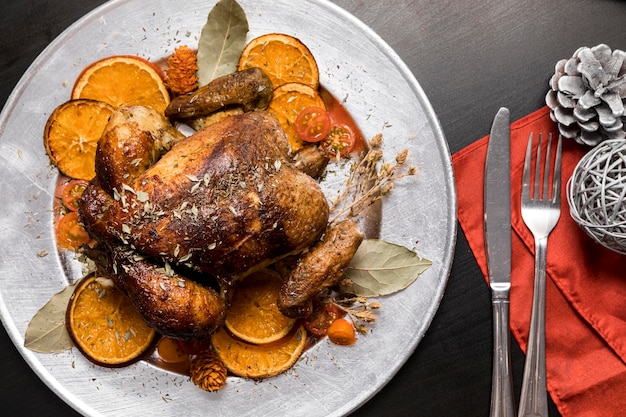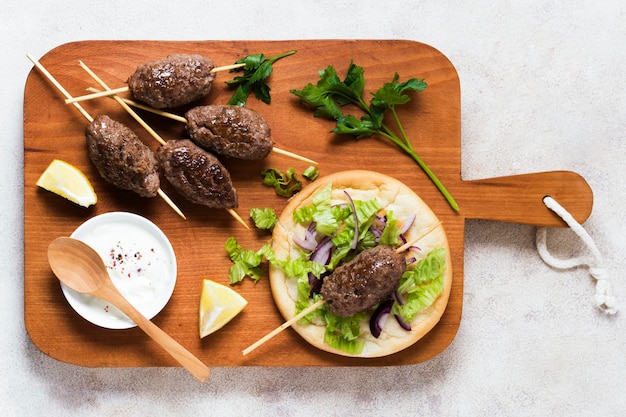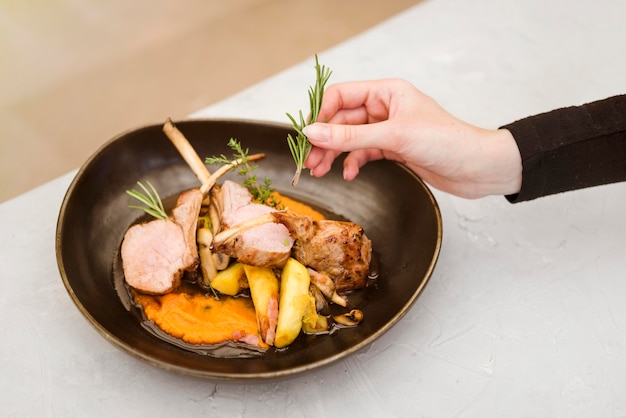(Part 1) The Essentials: Picking Your Leg of Lamb

The first thing you need to do is choose your leg of lamb. Now, this is where it gets interesting. You've got your options, see? There’s the classic boned and rolled leg, which is super easy to carve and cook. Then there’s the whole leg, which is a bit more rustic, perfect for a real showstopper. And then you've got the shoulder, which is a bit more budget-friendly and makes for some darn good slow cooking. But for this guide, we're going to focus on the good old boned and rolled leg. Why? Because it's just the right mix of elegance and ease.
The Importance of Freshness
The quality of your lamb will make a huge difference in the final dish. Opt for fresh, locally sourced lamb whenever possible. Look for a butcher you trust who can advise you on the best cuts and cuts of meat. A good butcher can often give you tips on how to prepare and cook your lamb for optimal results.
choosing the right cut
Let's talk about the cut. It's all about that marbling, the swirls of fat throughout the meat. The more marbling, the more flavour and juiciness you're going to get. Now, when I'm at the butcher, I'm always looking for that good, even marbling, and I always ask for the "middle cut." It's the sweetest spot on the leg, you see. It tends to be more tender and less prone to dryness than the top or bottom portions of the leg. Just a little tip from a seasoned lamb enthusiast!
The Weight Game
Now, weight. It depends on how many people you're feeding, really. I usually go for a 2.5kg leg for a crowd of six, but you can always go bigger or smaller depending on your needs. Don't forget, lamb cooks down a bit, so a big leg will shrink a little bit during cooking. A good rule of thumb is to allow about 200g per person for a main course, but you can always adjust based on your guests' appetites.
(Part 2) Getting Ready: Prepping Your Lamb

You've got your leg of lamb, now it's time to make it shine!
A Quick Pat Down
First, give your lamb a good pat down with some kitchen paper. We want it nice and dry, you see. That helps the skin to crisp up beautifully during cooking, which is key to a good lamb roast. A dry surface also helps the seasoning adhere properly, ensuring a more flavorful outcome.
Seasoning: The Flavour Game
Now, the seasoning. This is where you get to unleash your creativity! I love keeping things simple with salt, pepper, and maybe a touch of garlic powder. But you can go wild, adding herbs like rosemary, thyme, or oregano. The key is to rub the seasoning all over the lamb, really getting it into those crevices. It's all about that flavour penetration!
For a more complex flavour profile, try using a spice rub. Combine your favourite spices like cumin, paprika, coriander, and cayenne pepper with a little salt and pepper. A good spice rub not only adds flavor but can also create a beautiful crust on the lamb as it cooks.
The Importance of Resting
You know what's a good trick? Let your lamb rest in the fridge for a good 2-3 hours, or even overnight if you’ve got the time. This gives the flavours a chance to really seep into the meat. Just don't forget to cover it up with some cling film so it doesn’t dry out.
(Part 3) The Cooking Methods: Mastering the Roast

Now, let's talk about the fun part! Cooking your leg of lamb. There are a few ways to go about it. I'll be honest, my go-to is the oven, but I’ve got a few other tricks up my sleeve.
The oven method: Tried and Tested
This is the classic method, and it’s always a winner. Preheat your oven to 180 degrees Celsius (350 Fahrenheit), then pop your lamb in a roasting tin. I like to add a bit of water to the bottom of the tin to create some steam, which helps to keep the lamb moist. You'll want to cook it for about 1 hour and 45 minutes for a 2.5kg leg, checking the temperature with a meat thermometer to make sure it reaches 63 degrees Celsius (145 Fahrenheit).
The slow cooker method: A Relaxed Approach
If you're looking for a hands-off approach, the slow cooker is your new best friend. Just pop your lamb in with some chopped vegetables like onions and carrots, then let it cook on low for 6-8 hours. You can also add some wine or broth for extra flavour. This method is perfect for a busy weeknight or for a weekend when you want to spend more time with your guests.
The Barbecue Method: Outdoor Delights
Now, if you're blessed with a barbecue, why not take your lamb outdoors? Just get your grill nice and hot, then cook your lamb over medium heat, turning it every 15 minutes or so. It will take a bit longer than the oven method, but the smoky flavour is worth it, trust me! For this method, it's best to use a whole leg of lamb as it lends itself better to cooking over indirect heat. If using a boned and rolled leg, consider wrapping it in foil to prevent it from drying out.
(Part 4) The Resting Ritual: Letting the Lamb Settle In
Okay, so your lamb is cooked to perfection, but don't slice it straight away. You've got to let it rest, see. Just like a good cup of tea, it needs some time to chill out and let all those juices redistribute. I usually give it about 15 minutes, covered with some foil. This way, you get those tender, juicy slices, rather than a dry and disappointing result.
While the lamb is resting, you can prepare your side dishes and sauce. This is a great way to make sure everything is ready to serve when the lamb is finally ready to be carved.
(Part 5) Carving the Lamb: A Masterclass in Meat Mastery
Right, time to carve your lamb! Now, this might seem daunting, but it's actually pretty straightforward. First, you'll need a good, sharp carving knife. You want something that can slice through the meat like butter, you see.
The Art of the Slice
Now, the actual carving. Start by carving away the fat from the top, then slice the lamb against the grain. The grain is the direction of the muscle fibers. You want to cut across the grain to make the meat tender and easy to chew. For the boned and rolled leg, this is a relatively simple process. If you're using a whole leg, you may need to make a few cuts along the bone to make it easier to carve.
Presenting Your Masterpiece
Once you've got your slices, arrange them on a platter and serve. Don't forget to drizzle some of the delicious pan juices over the top. And remember, if you've got any leftovers, they're even better the next day. You can reheat them gently in the oven or microwave, or use them to make a delicious sandwich or salad.
(Part 6) The Ultimate Side Dish Showdown
No lamb roast is complete without a proper side dish, wouldn’t you say? This is your chance to bring on the flavours and textures to complement your culinary masterpiece.
The Classics: roasting potatoes and green beans
You can't go wrong with a good old roast potato, can you? Crispy on the outside, fluffy on the inside, they're the ultimate side dish for a roast lamb. Just toss them in some olive oil, salt, and pepper, and roast them until golden brown. And for a touch of green, some steamed green beans will do the trick nicely. They're a classic for a reason, you know?
The Mediterranean Touch: Lemon and Herb Roasted Vegetables
For a bit of Mediterranean flair, try roasting some vegetables like carrots, zucchini, and peppers. Drizzle them with olive oil, lemon juice, and herbs like rosemary and thyme. They'll be sweet, juicy, and full of flavour. For added depth, try adding a little garlic and a pinch of red pepper flakes to the roasting pan.
The Rich and Creamy: Creamy Mash and Peas
If you're after something a bit more indulgent, you can't beat creamy mashed potatoes. Just mash some cooked potatoes with butter, milk, and a touch of nutmeg for a luxurious side dish. And to add a bit of colour and freshness, serve them with some steamed peas.
The Seasonal Option: Root Vegetable Mash
If you want to incorporate more seasonal flavors, consider making a root vegetable mash. Combine parsnips, carrots, and sweet potatoes, roast them until tender, and then mash them with a little butter, milk, and salt and pepper. This creamy, earthy mash is a delicious alternative to mashed potatoes.
(Part 7) Sauce It Up: Elevating Your Lamb Roast
Now, let's talk about sauce. You know, that extra touch of flavour that takes your lamb roast to the next level. You’ve got lots of options here, from simple gravy to decadent red wine jus.
The Basic Gravy: Simple and Delicious
If you want to keep things simple, you can't go wrong with a good gravy. Just deglaze your roasting tin with some red wine or broth, then whisk in some flour and simmer until thickened. Easy, right? For a richer flavour, add a tablespoon of butter to the gravy before serving.
The Mint Sauce: A Classic Pairing
Mint sauce is a classic companion for lamb. It adds a fresh and herbaceous flavour that balances the richness of the meat. You can make it yourself, or you can grab a jar from the shop.
For a homemade mint sauce, combine chopped fresh mint leaves with olive oil, lemon juice, sugar, and a pinch of salt. Let the flavors meld for at least 30 minutes before serving.
The Red Wine Jus: A Rich and Complex Sauce
For a richer and more complex sauce, try making a red wine jus. Just simmer some red wine with shallots, garlic, and herbs like thyme and rosemary, then strain and thicken it with butter. It's an absolute delight!
For a deeper flavor, add a spoonful of red wine vinegar to the jus. This will add a touch of acidity that will balance the richness of the wine and the lamb.
(Part 8) FAQs: Your Lamb Roast Questions Answered
What happens if I overcook the lamb?
Overcooked lamb will be dry and tough. To avoid this, make sure you cook it to the right temperature. Use a meat thermometer to check the internal temperature. For a medium-rare lamb, it should be 63 degrees Celsius (145 Fahrenheit). For a medium lamb, aim for 65 degrees Celsius (149 Fahrenheit).
If you don't have a meat thermometer, you can use the old-fashioned method of checking the lamb's juices. When you pierce the lamb with a knife, the juices should run clear. If they're still pink, it needs to cook a bit longer. However, this method is less reliable than using a thermometer.
Can I freeze the leftover lamb?
Yes, you can freeze leftover lamb. Just make sure to wrap it tightly in cling film and store it in a freezer-safe container. It will keep for up to 3 months. When you're ready to use it, defrost the lamb in the fridge overnight and then reheat it gently in the oven or microwave. Frozen lamb is best used for dishes like stews, curries, or shepherd's pie, as it may become slightly drier after freezing.
What can I do with leftover lamb?
Leftover lamb is a gift, really! You can use it to make sandwiches, salads, or even a delicious shepherd’s pie. Just get creative and experiment with different flavours.
Here are a few ideas:
- Lamb salad: Combine leftover lamb with mixed greens, cherry tomatoes, cucumber, red onion, and a lemon vinaigrette dressing.
- Lamb sandwiches: Use leftover lamb to make sandwiches with crusty bread, hummus, and a sprinkle of fresh parsley.
- Lamb curry: Add leftover lamb to a flavorful curry sauce with potatoes, onions, and your favorite curry spices.
- Lamb tacos: Make a delicious and easy lamb taco filling by shredding the leftover lamb and mixing it with your favorite taco seasoning.
What if I don't have a meat thermometer?
If you don't have a meat thermometer, you can use the old-fashioned method of checking the lamb’s juices. When you pierce the lamb with a knife, the juices should run clear. If they're still pink, it needs to cook a bit longer. However, this method is less reliable than using a thermometer, as the juices can still appear clear even if the lamb is not cooked through.
(Part 9) A Final Word: Enjoying Your Lamb Roast
Now, let's be honest, the whole point of cooking a leg of lamb is to enjoy it. So, gather your loved ones around the table, share stories, and savour every bite. It's about the joy of cooking and the pleasure of sharing a delicious meal. And if you're feeling extra fancy, you can even put on a nice bottle of red wine to go with it. After all, life’s too short for boring lamb roasts!
(Part 10) Essential Equipment for Your Lamb Roast
To ensure success in your lamb roast adventure, you'll want to have a few essential pieces of equipment on hand.
1. Roasting Tin
A roasting tin is a must-have for cooking a leg of lamb. It should be large enough to hold the leg comfortably and have high sides to prevent the juices from spilling out.
2. Meat Thermometer
A meat thermometer is crucial for ensuring your lamb is cooked to perfection. It's a small investment that will pay off in the long run.
3. Sharp Carving Knife
A sharp carving knife is essential for carving the lamb neatly and cleanly. Choose a knife with a long, thin blade for easy slicing.
4. Basting Brush
A basting brush is helpful for applying pan juices or sauce to the lamb while it's cooking. This helps to keep the meat moist and flavorful.
5. Kitchen Paper
Kitchen paper is essential for patting down the lamb before cooking and for cleaning up any spills.
(Part 11) Tips for Success: Mastering the Art of the Lamb Roast
Here are some extra tips to help you achieve the perfect lamb roast:
1. Don't Overcrowd the Roasting Tin
Ensure there is enough space in the roasting tin for the lamb to cook evenly. If the lamb is overcrowded, it may not cook properly and will likely be tough and dry.
2. Baste Regularly
Basting the lamb with its own juices or with a sauce during cooking helps to keep it moist and flavorful. Baste the lamb every 20-30 minutes for best results.
3. Let the Lamb Rest Before Carving
Allowing the lamb to rest for 15-20 minutes after cooking allows the juices to redistribute, resulting in a more tender and flavorful roast.
4. Don't Overcook the Lamb
Overcooked lamb will be dry and tough. Use a meat thermometer to check the internal temperature and cook it to the desired level of doneness.
5. Serve with a Delicious Sauce
A flavorful sauce will enhance the taste of your lamb roast. Consider making a simple gravy, a minty sauce, or a rich red wine jus.
Everyone is watching

Corn on the Cob: The Ultimate Guide to Perfectly Cooked Ears
Healthy MealsAh, corn on the cob. Just the name evokes images of sunny days, barbecues, and that sweet, juicy flavour that ...

Perfect Pork Roast Oven Cooking Time: A Guide to Delicious Results
Healthy MealsThere's something truly satisfying about a perfectly roasted pork. The aroma alone is enough to make your mout...

Scallops: The Ultimate Guide to Perfect Cooking
Healthy MealsAh, scallops. Those delicate, sweet, and utterly delicious morsels of the sea. They hold a special place in my...

Ham Cooking Time: How Long to Bake, Smoke, or Boil a Delicious Ham
Healthy MealsAh, ham. It's a classic, isn't it? A real crowd-pleaser, especially around holidays. And when done right, it'...

Spaghetti Squash: The Ultimate Guide to Cooking and Serving
Healthy MealsRemember that time you saw spaghetti squash at the supermarket, looking all bumpy and strange, and thought, "W...
